|
January 2016 - April 2016 |
| |
|
|
 |
|
 |
| |
Publisher: Chairman Gong-Ru Lin Editors: Professor
Chao-Hsin Wu, Ms. Hsiao-wen Lin June 30, 2016 |
| |
|
 |
|
Congratulations! GIPO professor Chung-Chih Wu receives the title of SID (Society for Information Display) Fellow!
Congratulations to GIPO professor Gong-Ru Lin and Tektronix on building the Optical Communication Joint Laboratory!
Congratulations to GIPO professor Chee-Wee Liu and professor Gong-Ru Lin for winning the “Distinguished Research Award” of the Ministry of Science and Technology, ROC.
|
|
 |
|
 |
|
| |
|
 |
|
March “GIPO Colloquium”
Highlights
(Compiled by Li-Chi Yao) |
|
|
4:30 pm, March 4 (Fri.), 2016 |
|
Speaker: |
Professor Fu-Jen Kao
(Institute of Biophotonics, National Yang-Ming University) |
|
Topic: |
Focus Awakens |
| |
Professor Fu-Jen Kao visited GIPO on March 4 (Fri.) in answer to the invitation of GIPO professor Sheng-Lung Huang, and delivered the speech “Focus Awakens” at auditorium 101, Barry Lam Hall. His speech was fascinating, and the professor interacted well with his audience. GIPO teachers and students participated with enthusiasm and learned a great deal. |
|
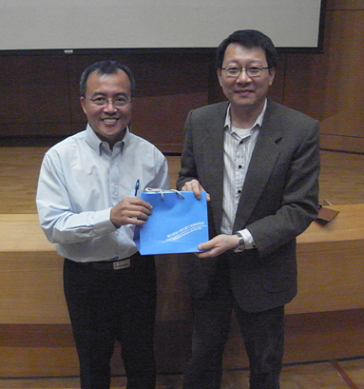 |
|
Professor Fu-Jen Kao (left) and GIPO chairman, Professor Gong-Ru Lin (right) |
|
|
|
4:30 pm, March 18 (Fri.), 2016 |
|
Speaker: |
Professor Yu-Lung Lo
(Dept. of Mechanical Engineering, National Cheng Kung University) |
|
Topic: |
Functional OCT System and SPR Sensor for Bio-applications |
| |
Professor Yu-Lung Lo visited GIPO on March 18 (Fri.) and delivered a speech concerning “Functional OCT System and SPR Sensor for Bio-applications” at room 113, Barry Lam Hall. His speech was very interesting and informative, and the professor interacted well with his audience. GIPO teachers and students participated with enthusiasm and learned a great deal. |
|
 |
|
Professor Yu-Lung Lo (left) and GIPO vice chairman, Professor Jian-Jang Huang (right) |
|
|
|
3:30 pm, March 23 (Wed.), 2016 |
|
Speaker: |
Professor Yun-Feng Xiao
(Micro-cavity photonics & quantum optics research team, Peking University) |
|
Topic: |
Ultrahigh-Q optical microcavity optics and photonics |
| |
Professor Yun-Feng Xiao visited GIPO while taking part in the NTU-Peking University’s day activity on March 23 (Fri.) and delivered a speech concerning “Ultrahigh-Q optical microcavity optics and photonics” at auditorium 105, EE-II Building. His speech was fascinating, and the professor interacted well with his audience. GIPO teachers and students participated with enthusiasm and learned a great deal. |
|
|
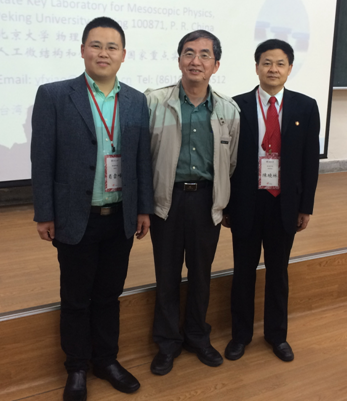 |
|
A group photo of Professor Yun-Feng Xiao (left), GIPO professor Lon A. Wang (middle), and Professor Xiao-Lin Chen of Peking University (right) |
|
|
|
4:30 pm, March 25 (Fri.), 2016 |
|
Speaker: |
Professor Lihong V. Wang (Optical Imaging Lab, Dept. of Biomedical Engineering, Washington University in St. Louis) |
|
Topic: |
Redefining the Spatiotemporal Limits of Optical Imaging: Photoacoustic Tomography, Wavefront Engineering, and Compressed Ultrafast Photograph |
| |
Professor Lihong V. Wang visited GIPO on March 25 (Fri.) at the invitation of GIPO professor Chi-Kuang Sun. The professor gave a speech “Redefining the Spatiotemporal Limits of Optical Imaging: Photoacoustic Tomography, Wavefront Engineering, and Compressed Ultrafast Photograph” at auditorium 101, Barry Lam Hall. His speech was very informative, and the professor interacted well with students. GIPO teachers and students participated with enthusiasm. |
|
 |
|
Professor Lihong V. Wang (right) and GIPO professor Chi-Kuang Sun
(left), the host of this speech |
|
|
|
3:30 pm, March 29 (Tue.), 2016 |
|
Speaker: |
Professor Milton Feng
(Micro and Nanotechnology Laboratory, Department of Electrical and Computer Engineering, University of Illinois at Urbana-Champaign) |
|
Topic: |
Direct Modulated VCSEL at 85 C with 50 Gb/s Error-Free Data Transmission without the use of Pre-Emphasis and Equalizer |
| |
Professor Milton Feng visited GIPO on March 29 (Tue.) and delivered a speech concerning “Direct Modulated VCSEL at 85 C with 50 Gb/s Error-Free Data Transmission without the use of Pre-Emphasis and Equalizer” at auditorium 101, Barry Lam Hall. His speech was fascinating and the professor interacted well with his audience. GIPO teachers and students participated with enthusiasm, and learned a great deal. |
|
 |
|
Professor Milton Feng (right), and GIPO chairman, Professor Gong-Ru Lin (left) |
~ 2015 GIPO Year-end Party ~
(Time: Dec. 28, 2015; Location: 3F courtyard of Ming-Da Hall, EECS, NTU)
Compiled by
Yu-Ting Huang, the president of GIPO Student Association
The GIPO Student Association organized a year-end party to celebrate the end of a busy semester. There were delicious food, amazing performances, fun games and an exciting lottery.
|
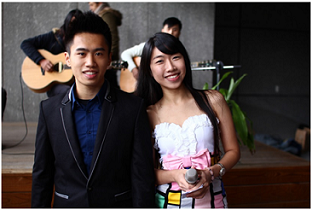 |
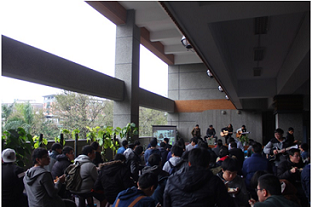 |
|
Our handsome/beautiful host/hostess, Parker Peng & Tiffany Wang |
The students absorbed in the performance |
First of all, we had the popular band Wooden Glasses warm up the party with a set. Next, GIPO chairman, Gong-Ru Lin, addressed students and encouraged us to work hard for a bright future. Then GIPO students, who are highly accomplished academically, showed that they possessed other incredible talents as well. One student brought us to tears with his rendition of “Wandering to Tamsui”. Another student performed amazing magic, making something appear out of nothing, and dazzling us with a variety of tricks. All of the performances kept our audience spellbound.
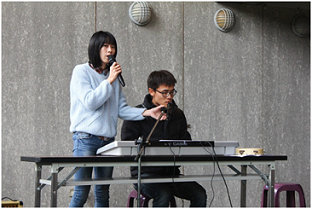 |
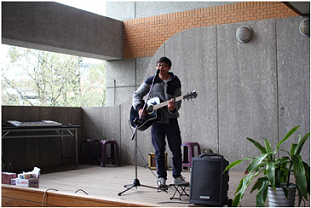 |
|
Ting-An Ku & Xue-Qian You Duet love song |
“Wandering to Tamsui”, Yen-Chang Chen |
 |
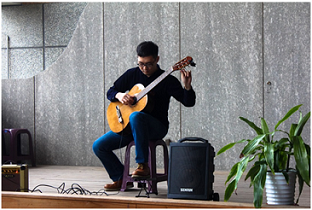 |
|
GIPO chairman addressing the party |
Guitar playing, Peng-Jui Wang |
 |
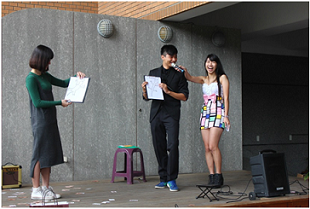 |
|
“Pigeons”, Bruce Liu |
“I would like to comprehend your heart” |
For this year’s exciting games, we tested everyone’s knowledge of our institute with “GIPO Knowledge King”. Both the contestants on the stage and the audiences below wracked their brains to figure out the answer to each question, which must have helped everyone develop their thinking capabilities. We also brought in our longtime partner PAPAGO to provide the delicious food for the noon. All the plates were empty by the end of the party, and we could tell that students enjoyed the food.
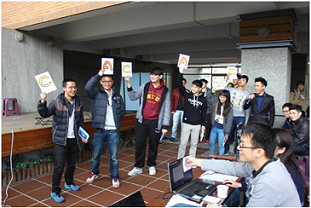 |
 |
|
The 2nd from the left is this year’s GIPO Knowledge King, Kuo-You Huang |
Students bursting into laughter |
For the party’s highly-anticipated lottery, we
provided lots of Haagen-Dazs ice cream vouchers,
Warner Vieshow Cinemas’ tickets, Wowprime
Corp.’s meal vouchers and 3C products for
winners to take home. The top prize was an iPad
mini, and we were honored to have Professor
Yuh-Renn Wu and Professor Chao-Hsin Wu draw the
winners for us, which made the lottery even more
exciting.
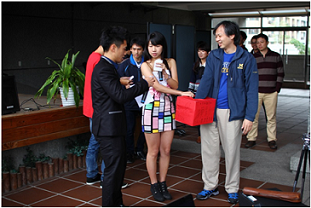 |
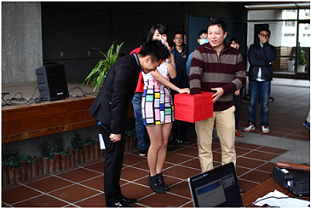 |
|
Professor Yuh-Renn Wu is drawing for the lottery |
Professor Chao-Hsin Wu is drawing for the lottery |
As this semester’s GIPO Student Association activities draw to a close, we would like to thank the professors and office staff for their kind help and timely suggestions. We would also like to thank our hardworking association members; we couldn’t have possibly done such a great job without your contributions. Thank you all!
|
|
 |
|
 |
|
| |
|
 |
Suppression of Current Collapse in Enhancement Mode AlGaN/GaN High Electron Mobility Transistors
Professor Jian-Jang Huang's laboratory
Graduate Institute of Photonics and
Optoelectronics, National Taiwan
University
AlGaN/GaN high electron mobility transistors (HEMTs) for RF and power applications have been researched and developed for over 20 years now and have met/exceeded many of the goals initially pursued by its researchers. In recent years there is strong demand for GaN power devices on Si substrates. In this work, the phenomenon of current collapse of E-mode HEMTs with the p-GaN cap layer was studied with (device B) and without (device A) SiO2 passivation. By extracting normalized Ron of our devices at different gate stress, it is demonstrated that device B has less severe current collapse within the gate stress of -15V. QSCV indicates that donor-like traps in SiO2/GaN interface and within the SiO2
layer suppresses electrons on the epi-structure surface and within the p-GaN cap layer, thus maintaining the channel carriers and mitigating current collapse.
|

|
|
Fig. 1 (a) Illustration of the setup for current collapse measurement. (b) The waveform of the node VG
and VD in the dynamic measurement. VDD is 40V in the test. |
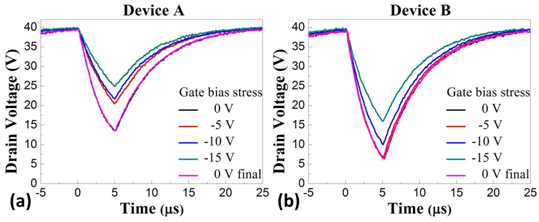 |
|
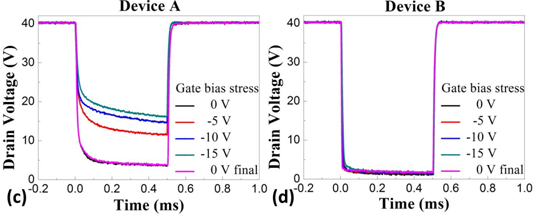
|
|
Fig. 2 Transient response of the dynamic measurement of (a) device A (without SiO2 passivation) and (b) device B (with SiO2 passivation) with the measurement duration 5µs. A longer measurement of 500µs was also performed and shown in (c) for device A and (d) for device B. The gate bias stress is 0, -5, -10 and -15V, and the post stress measurement is called “0V final”. |
|
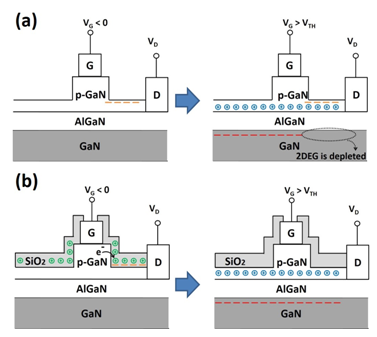
|
|
Fig. 3 Illustration of the carrier flows in the devices. (a) shows carrier trapping in device A while (b) is the case for device B. Carrier distributions at the off-state but under the gate stress bias are drawn in the left figures while the switched-on conditions are shown in the right. |
Tunable Three-Leaf Trefoil-Type Corner Cube Retro-Reflector
Professor Jui-che Tsai
Graduate Institute of Photonics and
Optoelectronics, National Taiwan
University
We have developed a three-leaf trefoil-type corner cube retro-reflector (CCR) fabricated with the MUMPs polysilicon surface micromachining process. Unlike other MEMS CCRs, this CCR’s opening faces straight upward as its (1, 1, 1) direction, i.e., the direction along which the retro-reflection efficiency is maximum, is perpendicular to the substrate’s surface (Fig. 1). Simulation results show that the orthogonality of CCR plays an important role in the optical performance of the CCR. Two CCRs leaning against each other to form a CCR pair are also demonstrated (Fig. 2), showing the feasibility of achieving a linear CCR array. With the ability to independently set the on-off state of each CCR by employing an electrostatically actuated gap-closing mirror as one of the three reflecting “leaves,” a CCR array can be used to realize optical identification.
|

|
|
Figure 1 |
|
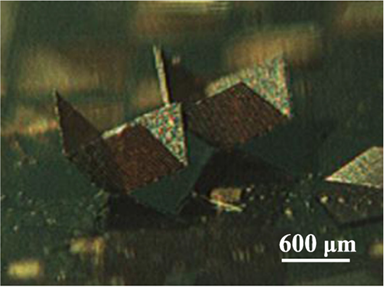
|
|
Figure 2 |
© 2015 IEEE
Y. F. Chen, B. J. Yang, and J. C. Tsai,
“Surface-micromachined MEMS tunable three-leaf
trefoil-type corner cube retro-reflector for
free-space optical applications,”
IEEE Journal of Selected Topics in
Quantum Electronics,
Vol. 21, No. 4, 2700907, Jul./Aug. 2015
InAsSb/InAsPSb multiple quantum well disk cavities with pedestal structures on a GaSb substrate for mid-infrared whispering gallery mode emission beyond 4 μm
Professor Ming-Hua Mao's laboratory
Graduate Institute of Photonics and
Optoelectronics, National Taiwan
University
The mid-infrared whispering gallery modes disk cavities with InAs0.85Sb0.15/InAs0.53P0.23Sb0.24 multiple quantum wells active medium on a GaSb substrate were fabricated. For this material system in the mid-infrared range, fabrication techniques were developed to form the disk cavity structure. The smooth sidewalls of the disk cavities were achieved by appropriate gas mixture flow ratio of BCl3/Ar in the inductively coupled plasma reactive ion etching. In addition, selective wet etching technique was used to from the pedestal of the disk cavity using dilute hydrofluoric acid with good selectivity. For efficient confinement of the whispering gallery modes along the radial direction, the extent of the lateral etching was carefully controlled. The processed 30-μm-diameter disk cavities were optically pumped, and the whispering gallery modes with wavelengths around 4.1 μm can be observed up to 90 K. This work has been published in Optics Letters, Vol. 40, No. 9, pp. 1904, (2015).
|
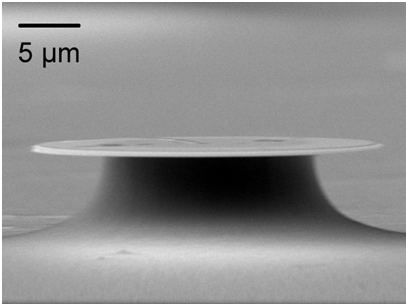
|
|
Fig. 1. Scanning electron microscope image of a fully processed disk cavity with a diameter of 30 μm. |
|
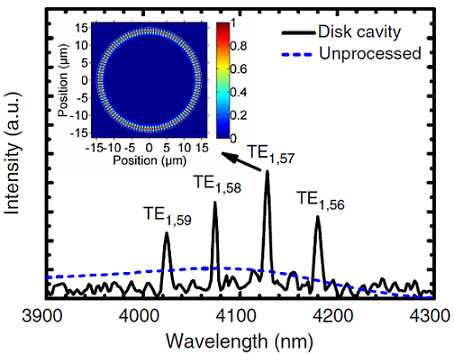
|
|
Fig. 2. Emission spectrum of a 30-μm-diameter disk cavity at 90 K. |
Modeling monochromatic light propagation through scattering medium via optical phase conjugation
Professor Snow H. Tseng
Graduate Institute of Photonics and
Optoelectronics, National Taiwan University
We model the propagation of monochromatic light through a macroscopic scattering medium by employing the pseudospectral time-domain (PSTD) simulation technique. Simulation results show that, with the appropriate amplitude and phase, monochromatic light can be directed through a scattering medium and focus into a narrow peak. Specifically, we compare: i)
focusing monochromatic light through a macroscopic scattering medium, and, ii)
focusing monochromatic light through vacuum. Based upon numerical solutions of
Maxwell’s equations, we show that the sub-diffraction focusing can be achieved
with
monochromatic
light of specific amplitude and phase; furthermore, simulation results
demonstrate that this phenomenon is insensitive to the scattering medium.
|
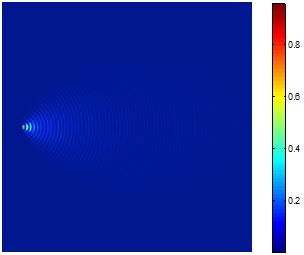
|
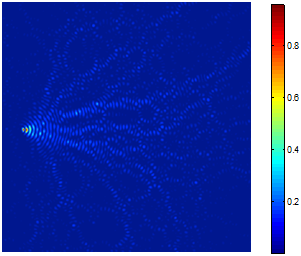 |
|
Fig. 1. (a) Light propagation through vacuum. (b) Light propagation through a scattering medium exhibits a sinuous, complex pattern resembling a network of branching water channels. |
|

|
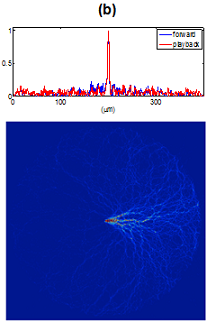 |
 |
|
Fig. 2. Simulation of light (λ
= 4 μm) back-propagated through a scattering medium consisting of 1600 6-μm-diameter dielectric cylinders, each with a refractive index (a)
n = 1.05, (b) n = 1.2, (c) n = 1.3, respectively. Inset-figures: Regardless of
n, the back-propagated light converges coherently and reconstructs the original light profile. |
Ionic polymer metal composite for an optical zoom in a compact camera
Professor Guo-Dung J. Su's laboratory
Graduate Institute of Photonics and
Optoelectronics, National Taiwan
University
The reflective method is utilized in the optical zoom function of a thin camera for the advantage of folding the optical path. An ionic polymer metal composite deformable mirror used in a reflective zoom system achieves large deformations to change optical power with a low bias voltage. Polydimethylsiloxane is used as a buffer layer to improve surface roughness. The surface roughness of this layer is about 17 nm. The optical focusing power of the deformable mirror reaches 73.8 m−1 diopters with 3 volts. A complete reflective camera module is fabricated using two ionic polymer metal composite deformable mirrors in the zoom function. The zoom ratio is about 1.6 ×. This work has been published in Optics Express, Vol. 23, Issue 10, pp. 13265-13277 (2015).
|
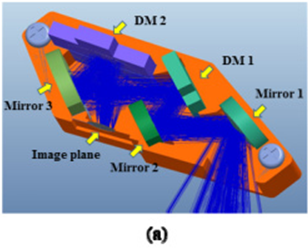
|
 |
|
Fig. 1. Optical zoom module (a) Simulation image (b) Entity image |
|
 |
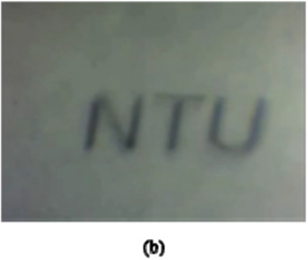 |
|
Fig. 2. Experimental results (a) Image at tele end (b) Image at wide end |
|
|
|
 |
|
 |
|
| |
|
|
 |
|
 |
|
|
|